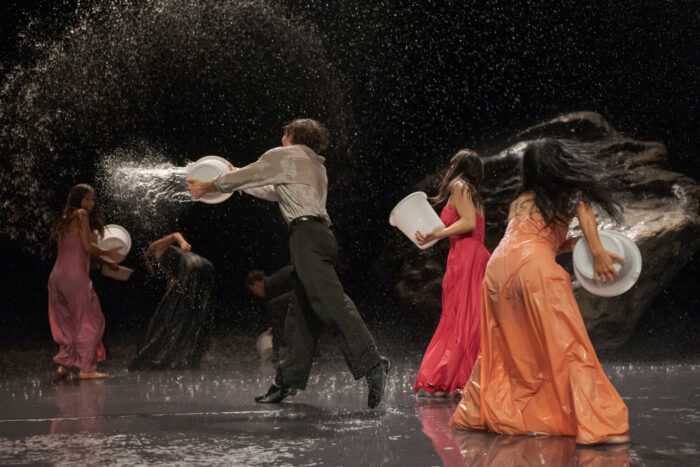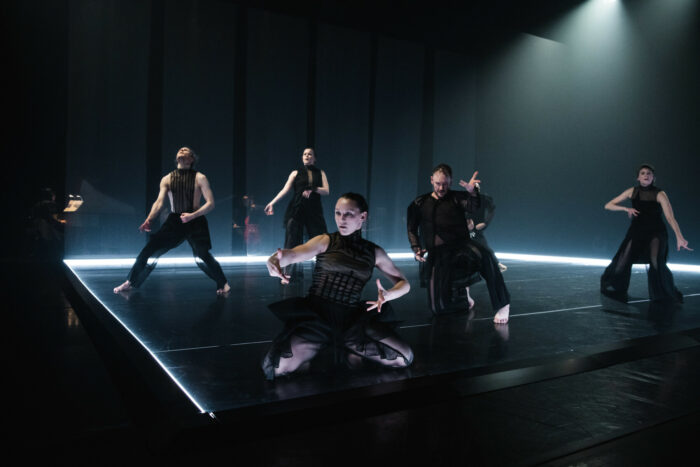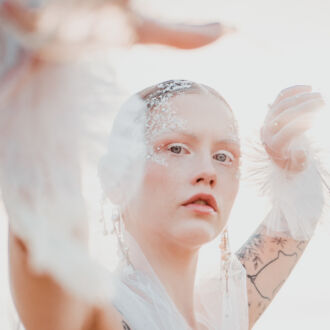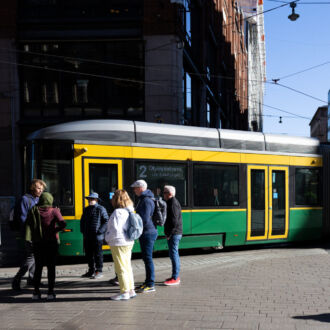Financial Times architecture and design critic Edwin Heathcote has called Dance House Helsinki “a series of spaces as full of power and potential as you could hope for.”
The Dance House resides in a new extension attached to one end of Cable Factory, in the neighbourhood of Ruoholahti, west of downtown. Though it retains its original, industrial name, the location has functioned as a cultural centre for decades, and houses several museums and a host of other cultural organisations.
Construction of the new building included enclosing an area between two wings of Cable Factory in glass, creating an airy foyer that now serves as an entrance hall and meeting place.
New chances for viewers and artists

Choreographer Tuomo Railo of Dance Theatre Glims & Gloms says his Bach Project originally developed out of improvisation and displays the “freshly squeezed juice of dance.”Photo: Ari Kauppila/Dance House Helsinki
The crown jewel of the new Dance House is Erkko Hall (named after the Jane and Aatos Erkko Foundation, a major donor). Designed specifically for dance performances, the space has a ground-level stage and can seat up to 700 people.
“I love the steep seating arrangement, because it allows every performer to be seen,” says Finnish dancer and choreographer Tero Saarinen. “Intimacy is maintained even if you sit in the last row.” He’s the artistic director of Tero Saarinen Company, one of Europe’s leading dance groups.
The company is a programme partner of Dance House Helsinki. “Both our artists and our audiences have been inspired by the new perspective and the boost the new space has brought,” says Saarinen, looking back on the venue’s first year.
Dance House Helsinki’s partners also include Cirko (Centre for New Circus), Dance Theatre Hurjaruuth (“dance and circus performances for children and adults”) and Zodiak (Centre for New Dance). A broad range of other groups and festivals hold events there, too. They’ve all been experimenting with the possibilities that the new space offers. In addition to Erkko Hall, the complex also features the 235-seat Pannu Hall.
Living the dream

When Tanztheater Wuppertal Pina Bausch visited Dance House Helsinki, their Full Moon included dancers dousing each other with buckets of water.Photo: Martin Argyroglo/Dance House Helsinki
“A space dedicated to dance is a dream that lived for decades among dancers,” says Dance House Helsinki programme manager Mikael Aaltonen. While the idea of a Finnish dance centre isn’t new – you can trace it back as far as the 1930s – it coalesced and reached a tipping point in the late 2000s. An association was founded in 2010 “to promote the creation of a proper space for dance art and culture in Helsinki,” Aaltonen says.
World-class performance spaces exist across Finland, including the Opera House in Helsinki, home to the Finnish National Ballet. However, not all venues have proved ideal for dance and contemporary circus productions.
“It is unique to have a new building designed and built for dance,” says Aaltonen. Perhaps the timing wasn’t entirely coincidental: In the late 2000s, Helsinkians were watching as construction progressed on the grand new Music Centre, which opened in 2011. That may have provided additional inspiration.
It’s your house, too

Natasha Lommi (front) dances in Tero Saarinen Company’s Third Practice at Dance House Helsinki.Photo: Kai Kuusisto/Tero Saarinen Company
“Finland has invested a lot in facilities for music, sports and literature – and rightfully so – but it was time to build one for dance as well,” says Saarinen. “I can only imagine what kind of identity booster it will be for the next generations of dance makers here in Finland.”
One member of Tero Saarinen Company is Natasha Lommi, who has a wide-ranging career as a dancer, choreographer and teacher. She also mentions the future of dance.
She views Dance House Helsinki as “a space where young people and young dancers, and people that are dreaming of becoming dancers, can see that this is a place that is for everyone,” she says. “I told my students, ‘This is your house as well.’”
Action-packed schedule

One Drop, conceptualised and choreographed by Sonya Lindfors and coproduced by Zodiak, is one of a series of works dealing with power, representation and Black body politics. It is in the Dance House Helsinki programme for May 2023.Photo: Tuukka Ervasti/Dance House Helsinki
The first year of performances showed what a customised, central dance venue contributes to Finland and its capital city. Attendance numbers totalled 56,000, even with two months of the schedule cancelled during Covid-19 restrictions. Dance House Helsinki has featured numerous Finnish and foreign choreographers and enabled new connections with international performers.
Tanztheater Wuppertal Pina Bausch visited from Germany with the monumental Full Moon, and Belgian choreographer Anne Teresa De Keersmaeker’s Mystery Sonatas / for Rosa combined contemporary choreography and baroque music. The National Dance Company of Korea came to Helsinki to perform the Finnish premiere of Vortex, which Tero Saarinen had choreographed for them back in 2014.
Matriarchy, a performance directed by Pauliina Feodoroff, delved into issues that are important to the indigenous Sámi people – and to everyone else, as well. (The far-northern homeland of the Sámi is split into four parts by the borders of Finland, Sweden, Norway and Russia.)
Also during the Dance House’s initial year, Hurjaruuth held its classic winter circus. Zodiak has produced numerous performances, including the ten-day Side Step Festival.
No barriers

The Australian circus company Gravity and Other Myths wowed Dance House audiences with innovative acrobatics.Photo: Carnival Cinema/Dance House Helsinki
For many of the productions, such as those by Zodiak and Tero Saarinen Company, a number of pay-what-you-can tickets are available. Anybody can afford to attend a performance.
At the time of writing, Dance House Helsinki is early in its second year, with a programme that includes the innovative acrobatics of Australian circus company Gravity and Other Myths; flamenco superstar Rocío Molina; the spring gala of the Finnish National Ballet’s school; a visit by the Lyon Opera Ballet; and several Tero Saarinen Company productions.
Silentopia, a Finnish interdisciplinary performance by Sivuun Ensemble, deals with the ecocrisis and features not only musicians and dancers, but scientists, too.
Dance scene dialogue

The piece down below things shudder, choreographed by Kaisa Nieminen and Marika Peura, “fantasises about the potentiality of dancing.”Photo: Venla Helenius/Dance House Helsinki
Also on the calendar are two productions from Sparks, an artistic development project at Dance House Helsinki supported by the Finnish Cultural Foundation. It supplies Finnish dance artists with resources for research, artist residency and production.
Elina Pirinen premieres Mortal Tropical Dances, which “connects intensively with the audience by dancing, playing, singing and praying out energy, sex, hope, madness, deep joy, suffering, humour, imagination, warmth and comfort,” according to the online description. Kaisa Nieminen and Marika Peura premiere down below things shudder, which “fantasises about the potentiality of dancing – rolling waves, tenacious bodies, the desire to dance overflowingly.”
Aaltonen calls Sparks “a great opportunity to introduce interesting Finnish artists to the public.” He refers to it as “establishing a dialogue with the Finnish dance scene.”
Vibrant dance community

Finnish choreographer Ismo-Pekka Heikinheimo’s Cycle studies “how circular movement repeats itself” in life and nature.Photo: Sakari Viika/Dance House Helsinki
Saarinen says he’s “proud of [Finland’s] vibrant dance community” and excited about all the groups visiting from abroad. “Helsinki is already one of the most exciting dance cities in Northern Europe, and, thanks to the Dance House, an even more important hub in the future,” he says.
“I hope that many different dance makers of different generations will enter these spaces, and surprise and enhance our understanding of what dance can be.”
By Emma De Carvalho, April 2023









